Development of Smart Dust Project for Melbourne Traffic Management
VerifiedAdded on 2021/06/15
|7
|1077
|19
Project
AI Summary
This project plan outlines the development of a smart dust project system for traffic management in Melbourne, Australia. The project aims to mitigate traffic congestion using a sensor-based wireless system composed of tiny particles deployed along roads to collect data and inform traffic management decisions. The plan details project objectives, milestones, stakeholder analysis, and expected benefits, including economic, social, and strategic advantages. Key milestones include roadmap development, system design and implementation, pilot testing, user training, and project execution. The project involves various stakeholders such as the Melbourne Metropolitan Authority, traffic drivers, and government agencies. The project team comprises system developers, analysts, legal advisors, and other specialists. Identified risks include system failure, bureaucratic delays, and user resistance. The project's anticipated outcomes include improved traffic flow and reduced congestion, supported by a detailed cost estimation. The project is expected to provide real-time information for traffic management and is designed to solve future traffic movement needs for the growing population in Melbourne city.
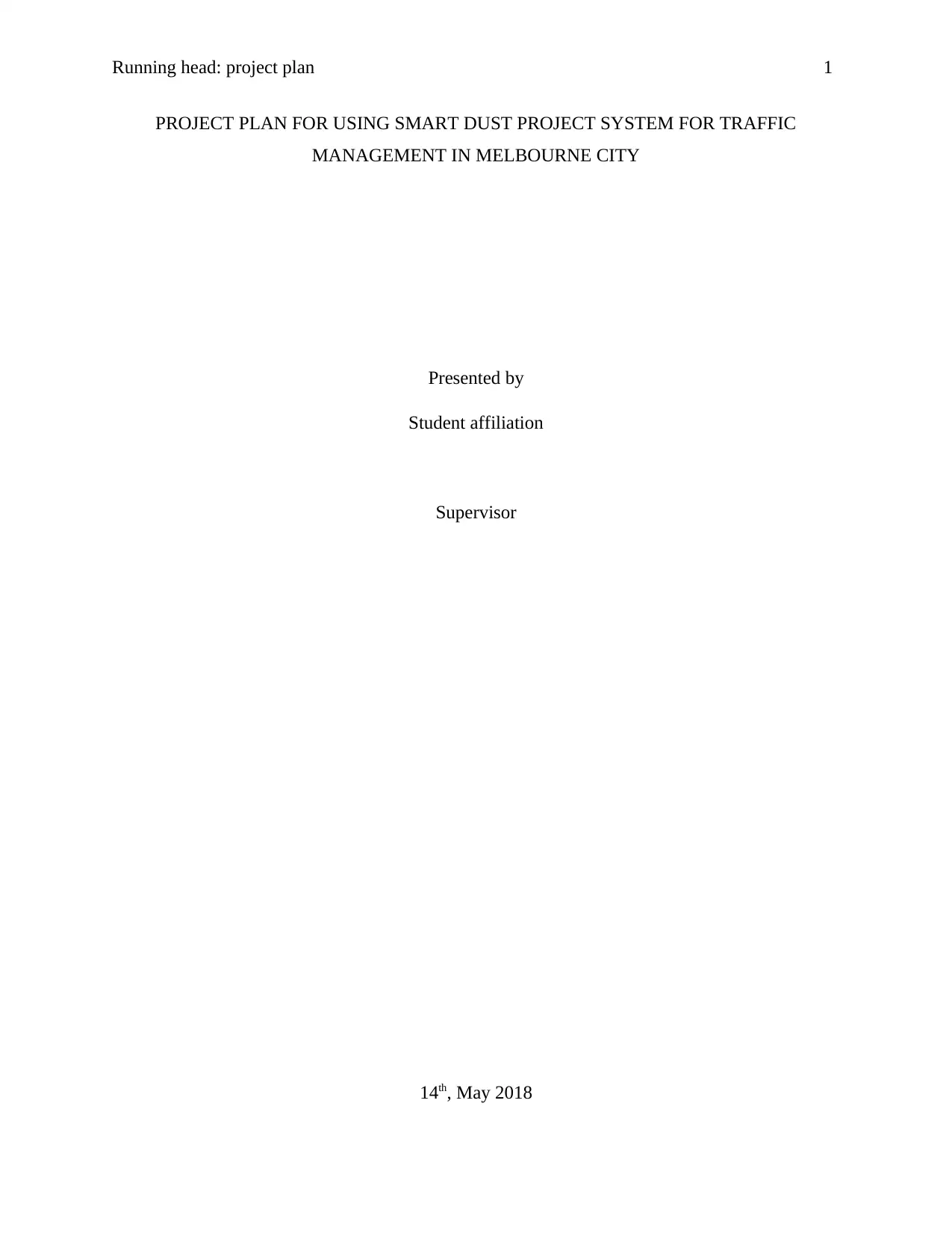
Running head: project plan 1
PROJECT PLAN FOR USING SMART DUST PROJECT SYSTEM FOR TRAFFIC
MANAGEMENT IN MELBOURNE CITY
Presented by
Student affiliation
Supervisor
14th, May 2018
PROJECT PLAN FOR USING SMART DUST PROJECT SYSTEM FOR TRAFFIC
MANAGEMENT IN MELBOURNE CITY
Presented by
Student affiliation
Supervisor
14th, May 2018
Paraphrase This Document
Need a fresh take? Get an instant paraphrase of this document with our AI Paraphraser
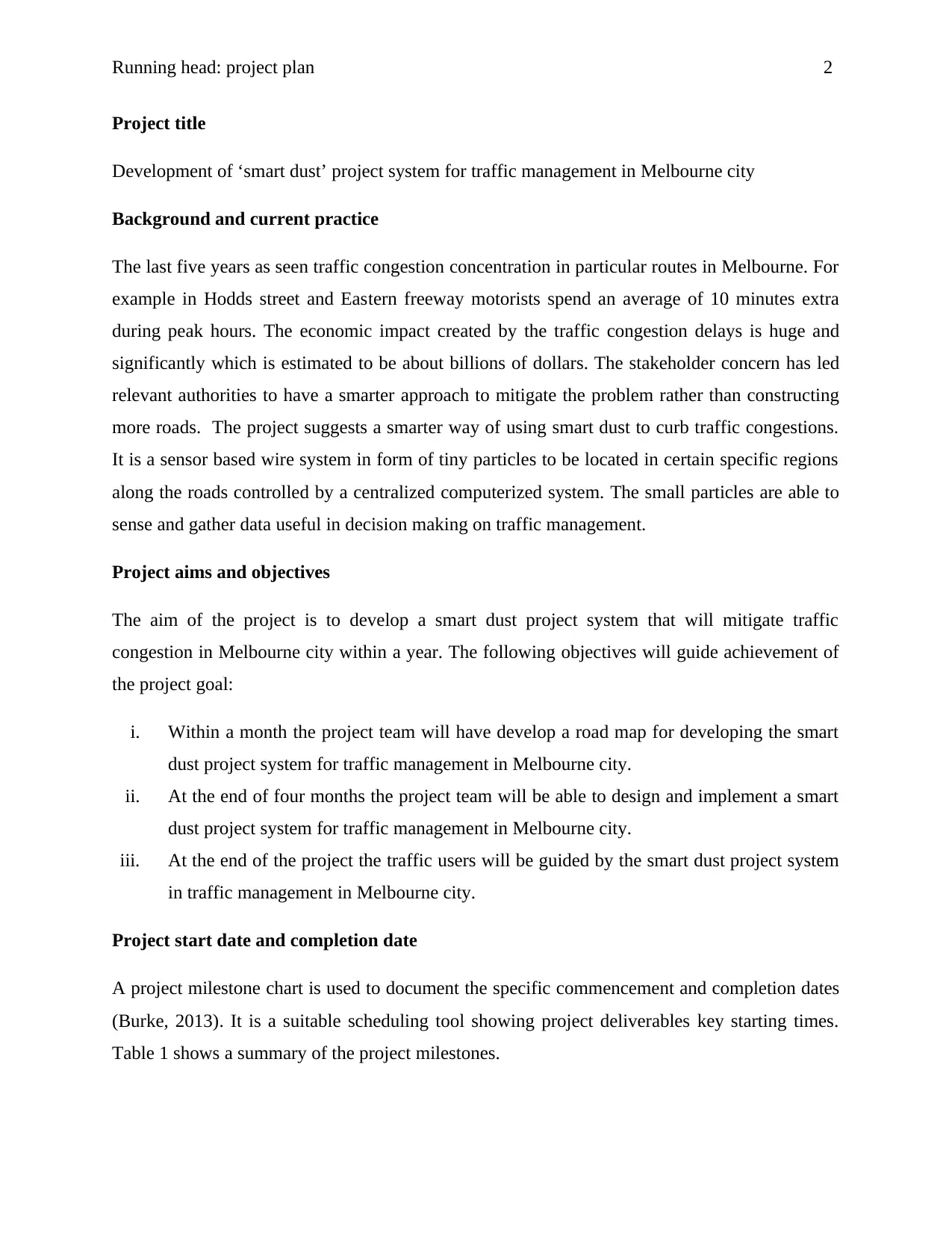
Running head: project plan 2
Project title
Development of ‘smart dust’ project system for traffic management in Melbourne city
Background and current practice
The last five years as seen traffic congestion concentration in particular routes in Melbourne. For
example in Hodds street and Eastern freeway motorists spend an average of 10 minutes extra
during peak hours. The economic impact created by the traffic congestion delays is huge and
significantly which is estimated to be about billions of dollars. The stakeholder concern has led
relevant authorities to have a smarter approach to mitigate the problem rather than constructing
more roads. The project suggests a smarter way of using smart dust to curb traffic congestions.
It is a sensor based wire system in form of tiny particles to be located in certain specific regions
along the roads controlled by a centralized computerized system. The small particles are able to
sense and gather data useful in decision making on traffic management.
Project aims and objectives
The aim of the project is to develop a smart dust project system that will mitigate traffic
congestion in Melbourne city within a year. The following objectives will guide achievement of
the project goal:
i. Within a month the project team will have develop a road map for developing the smart
dust project system for traffic management in Melbourne city.
ii. At the end of four months the project team will be able to design and implement a smart
dust project system for traffic management in Melbourne city.
iii. At the end of the project the traffic users will be guided by the smart dust project system
in traffic management in Melbourne city.
Project start date and completion date
A project milestone chart is used to document the specific commencement and completion dates
(Burke, 2013). It is a suitable scheduling tool showing project deliverables key starting times.
Table 1 shows a summary of the project milestones.
Project title
Development of ‘smart dust’ project system for traffic management in Melbourne city
Background and current practice
The last five years as seen traffic congestion concentration in particular routes in Melbourne. For
example in Hodds street and Eastern freeway motorists spend an average of 10 minutes extra
during peak hours. The economic impact created by the traffic congestion delays is huge and
significantly which is estimated to be about billions of dollars. The stakeholder concern has led
relevant authorities to have a smarter approach to mitigate the problem rather than constructing
more roads. The project suggests a smarter way of using smart dust to curb traffic congestions.
It is a sensor based wire system in form of tiny particles to be located in certain specific regions
along the roads controlled by a centralized computerized system. The small particles are able to
sense and gather data useful in decision making on traffic management.
Project aims and objectives
The aim of the project is to develop a smart dust project system that will mitigate traffic
congestion in Melbourne city within a year. The following objectives will guide achievement of
the project goal:
i. Within a month the project team will have develop a road map for developing the smart
dust project system for traffic management in Melbourne city.
ii. At the end of four months the project team will be able to design and implement a smart
dust project system for traffic management in Melbourne city.
iii. At the end of the project the traffic users will be guided by the smart dust project system
in traffic management in Melbourne city.
Project start date and completion date
A project milestone chart is used to document the specific commencement and completion dates
(Burke, 2013). It is a suitable scheduling tool showing project deliverables key starting times.
Table 1 shows a summary of the project milestones.
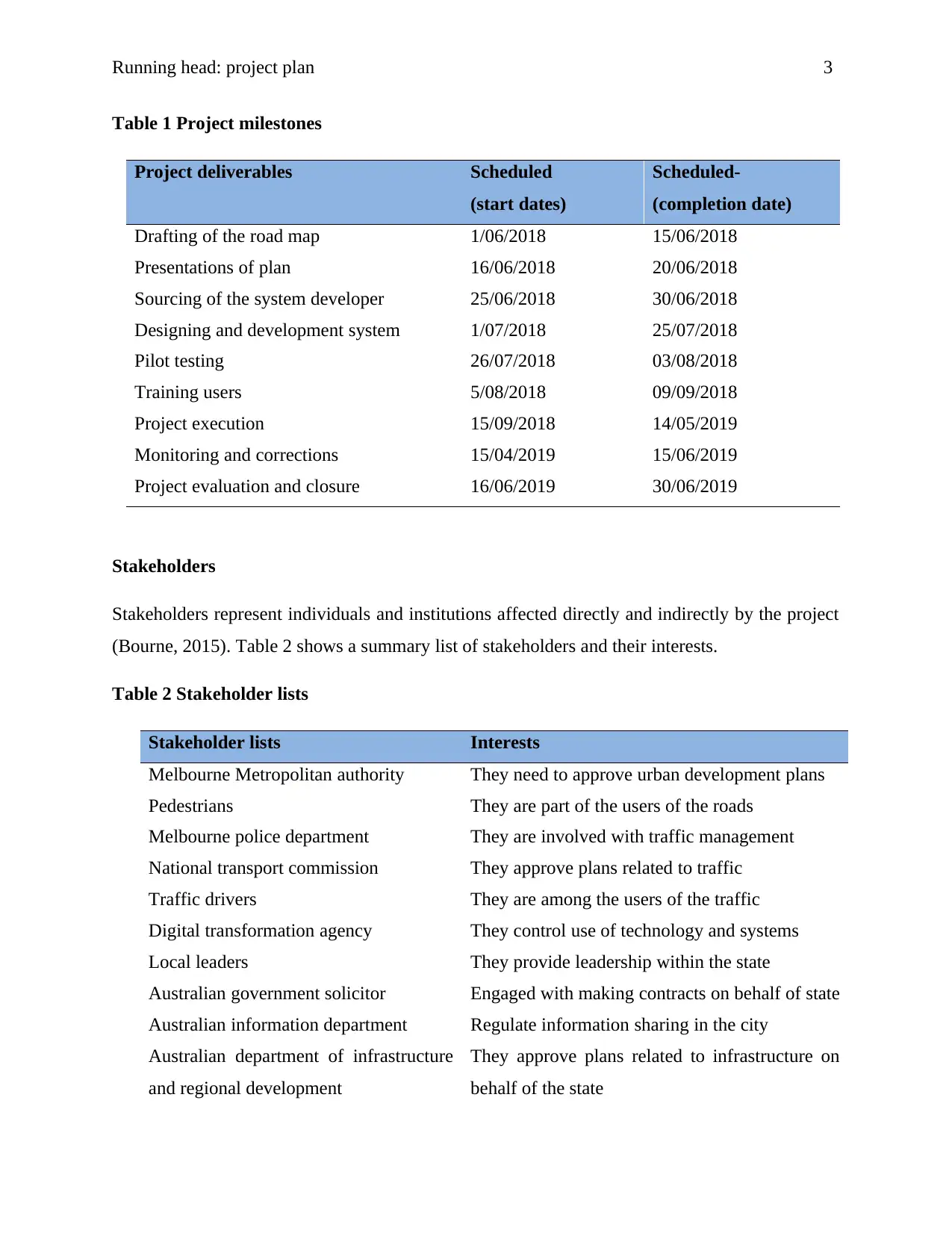
Running head: project plan 3
Table 1 Project milestones
Project deliverables Scheduled
(start dates)
Scheduled-
(completion date)
Drafting of the road map 1/06/2018 15/06/2018
Presentations of plan 16/06/2018 20/06/2018
Sourcing of the system developer 25/06/2018 30/06/2018
Designing and development system 1/07/2018 25/07/2018
Pilot testing 26/07/2018 03/08/2018
Training users 5/08/2018 09/09/2018
Project execution 15/09/2018 14/05/2019
Monitoring and corrections 15/04/2019 15/06/2019
Project evaluation and closure 16/06/2019 30/06/2019
Stakeholders
Stakeholders represent individuals and institutions affected directly and indirectly by the project
(Bourne, 2015). Table 2 shows a summary list of stakeholders and their interests.
Table 2 Stakeholder lists
Stakeholder lists Interests
Melbourne Metropolitan authority They need to approve urban development plans
Pedestrians They are part of the users of the roads
Melbourne police department They are involved with traffic management
National transport commission They approve plans related to traffic
Traffic drivers They are among the users of the traffic
Digital transformation agency They control use of technology and systems
Local leaders They provide leadership within the state
Australian government solicitor Engaged with making contracts on behalf of state
Australian information department Regulate information sharing in the city
Australian department of infrastructure
and regional development
They approve plans related to infrastructure on
behalf of the state
Table 1 Project milestones
Project deliverables Scheduled
(start dates)
Scheduled-
(completion date)
Drafting of the road map 1/06/2018 15/06/2018
Presentations of plan 16/06/2018 20/06/2018
Sourcing of the system developer 25/06/2018 30/06/2018
Designing and development system 1/07/2018 25/07/2018
Pilot testing 26/07/2018 03/08/2018
Training users 5/08/2018 09/09/2018
Project execution 15/09/2018 14/05/2019
Monitoring and corrections 15/04/2019 15/06/2019
Project evaluation and closure 16/06/2019 30/06/2019
Stakeholders
Stakeholders represent individuals and institutions affected directly and indirectly by the project
(Bourne, 2015). Table 2 shows a summary list of stakeholders and their interests.
Table 2 Stakeholder lists
Stakeholder lists Interests
Melbourne Metropolitan authority They need to approve urban development plans
Pedestrians They are part of the users of the roads
Melbourne police department They are involved with traffic management
National transport commission They approve plans related to traffic
Traffic drivers They are among the users of the traffic
Digital transformation agency They control use of technology and systems
Local leaders They provide leadership within the state
Australian government solicitor Engaged with making contracts on behalf of state
Australian information department Regulate information sharing in the city
Australian department of infrastructure
and regional development
They approve plans related to infrastructure on
behalf of the state
⊘ This is a preview!⊘
Do you want full access?
Subscribe today to unlock all pages.

Trusted by 1+ million students worldwide
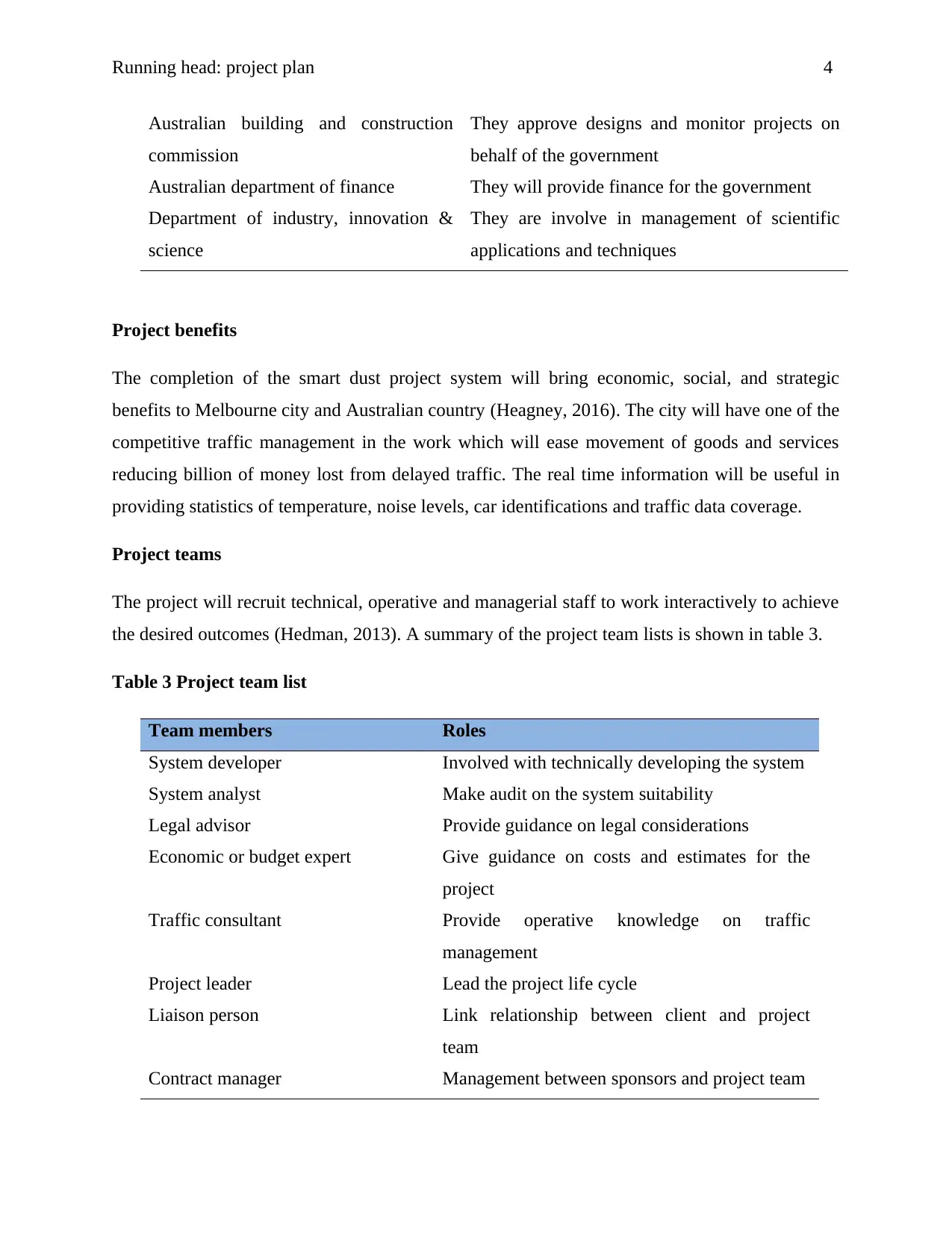
Running head: project plan 4
Australian building and construction
commission
They approve designs and monitor projects on
behalf of the government
Australian department of finance They will provide finance for the government
Department of industry, innovation &
science
They are involve in management of scientific
applications and techniques
Project benefits
The completion of the smart dust project system will bring economic, social, and strategic
benefits to Melbourne city and Australian country (Heagney, 2016). The city will have one of the
competitive traffic management in the work which will ease movement of goods and services
reducing billion of money lost from delayed traffic. The real time information will be useful in
providing statistics of temperature, noise levels, car identifications and traffic data coverage.
Project teams
The project will recruit technical, operative and managerial staff to work interactively to achieve
the desired outcomes (Hedman, 2013). A summary of the project team lists is shown in table 3.
Table 3 Project team list
Team members Roles
System developer Involved with technically developing the system
System analyst Make audit on the system suitability
Legal advisor Provide guidance on legal considerations
Economic or budget expert Give guidance on costs and estimates for the
project
Traffic consultant Provide operative knowledge on traffic
management
Project leader Lead the project life cycle
Liaison person Link relationship between client and project
team
Contract manager Management between sponsors and project team
Australian building and construction
commission
They approve designs and monitor projects on
behalf of the government
Australian department of finance They will provide finance for the government
Department of industry, innovation &
science
They are involve in management of scientific
applications and techniques
Project benefits
The completion of the smart dust project system will bring economic, social, and strategic
benefits to Melbourne city and Australian country (Heagney, 2016). The city will have one of the
competitive traffic management in the work which will ease movement of goods and services
reducing billion of money lost from delayed traffic. The real time information will be useful in
providing statistics of temperature, noise levels, car identifications and traffic data coverage.
Project teams
The project will recruit technical, operative and managerial staff to work interactively to achieve
the desired outcomes (Hedman, 2013). A summary of the project team lists is shown in table 3.
Table 3 Project team list
Team members Roles
System developer Involved with technically developing the system
System analyst Make audit on the system suitability
Legal advisor Provide guidance on legal considerations
Economic or budget expert Give guidance on costs and estimates for the
project
Traffic consultant Provide operative knowledge on traffic
management
Project leader Lead the project life cycle
Liaison person Link relationship between client and project
team
Contract manager Management between sponsors and project team
Paraphrase This Document
Need a fresh take? Get an instant paraphrase of this document with our AI Paraphraser
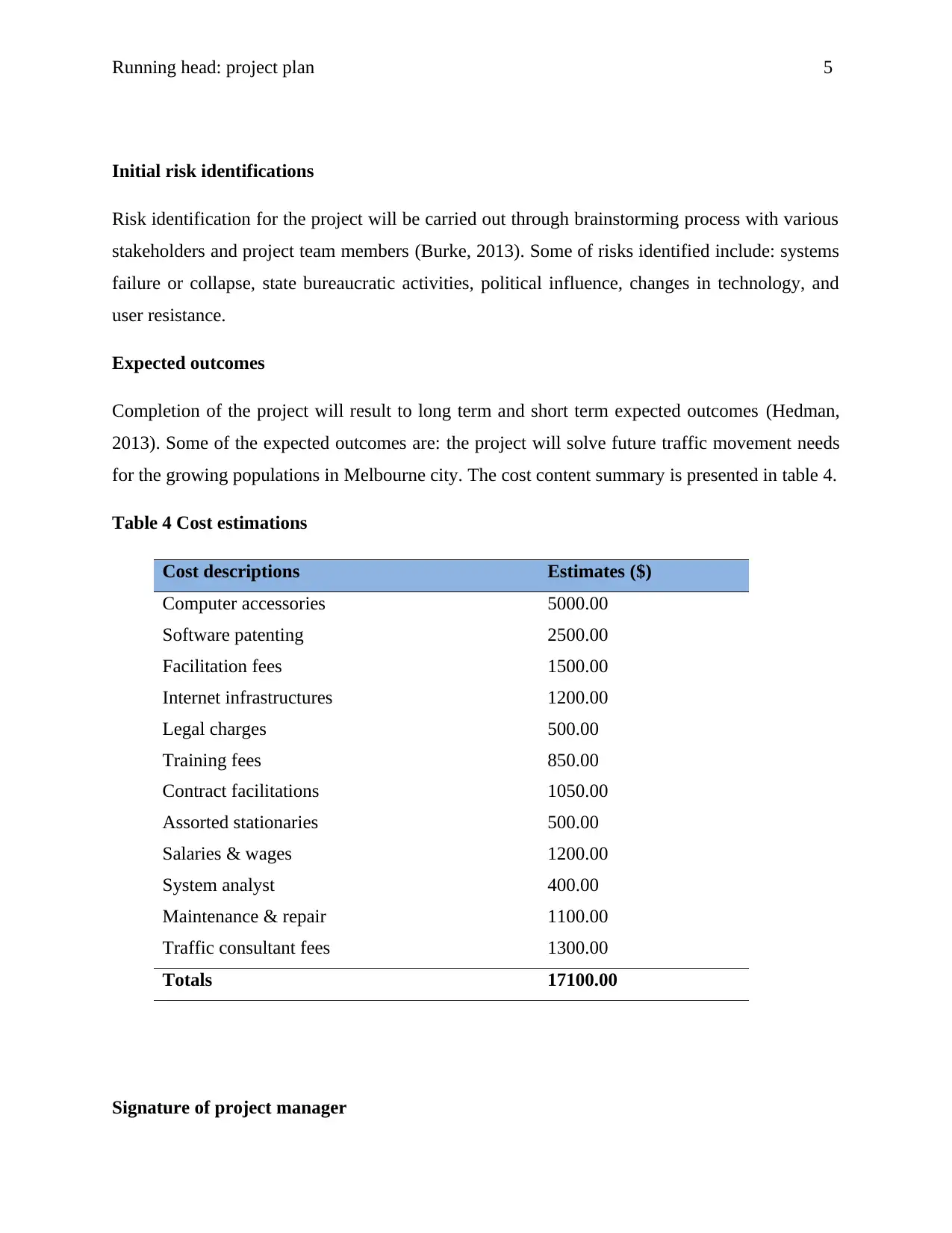
Running head: project plan 5
Initial risk identifications
Risk identification for the project will be carried out through brainstorming process with various
stakeholders and project team members (Burke, 2013). Some of risks identified include: systems
failure or collapse, state bureaucratic activities, political influence, changes in technology, and
user resistance.
Expected outcomes
Completion of the project will result to long term and short term expected outcomes (Hedman,
2013). Some of the expected outcomes are: the project will solve future traffic movement needs
for the growing populations in Melbourne city. The cost content summary is presented in table 4.
Table 4 Cost estimations
Cost descriptions Estimates ($)
Computer accessories 5000.00
Software patenting 2500.00
Facilitation fees 1500.00
Internet infrastructures 1200.00
Legal charges 500.00
Training fees 850.00
Contract facilitations 1050.00
Assorted stationaries 500.00
Salaries & wages 1200.00
System analyst 400.00
Maintenance & repair 1100.00
Traffic consultant fees 1300.00
Totals 17100.00
Signature of project manager
Initial risk identifications
Risk identification for the project will be carried out through brainstorming process with various
stakeholders and project team members (Burke, 2013). Some of risks identified include: systems
failure or collapse, state bureaucratic activities, political influence, changes in technology, and
user resistance.
Expected outcomes
Completion of the project will result to long term and short term expected outcomes (Hedman,
2013). Some of the expected outcomes are: the project will solve future traffic movement needs
for the growing populations in Melbourne city. The cost content summary is presented in table 4.
Table 4 Cost estimations
Cost descriptions Estimates ($)
Computer accessories 5000.00
Software patenting 2500.00
Facilitation fees 1500.00
Internet infrastructures 1200.00
Legal charges 500.00
Training fees 850.00
Contract facilitations 1050.00
Assorted stationaries 500.00
Salaries & wages 1200.00
System analyst 400.00
Maintenance & repair 1100.00
Traffic consultant fees 1300.00
Totals 17100.00
Signature of project manager

Running head: project plan 6
At the end of the project phase the approvals will be done by the project sponsor and manager.
Project manager…………………………..signature……………………….Date………………
Project sponsor…………………………..signature………………………..Date………………
References
At the end of the project phase the approvals will be done by the project sponsor and manager.
Project manager…………………………..signature……………………….Date………………
Project sponsor…………………………..signature………………………..Date………………
References
⊘ This is a preview!⊘
Do you want full access?
Subscribe today to unlock all pages.

Trusted by 1+ million students worldwide
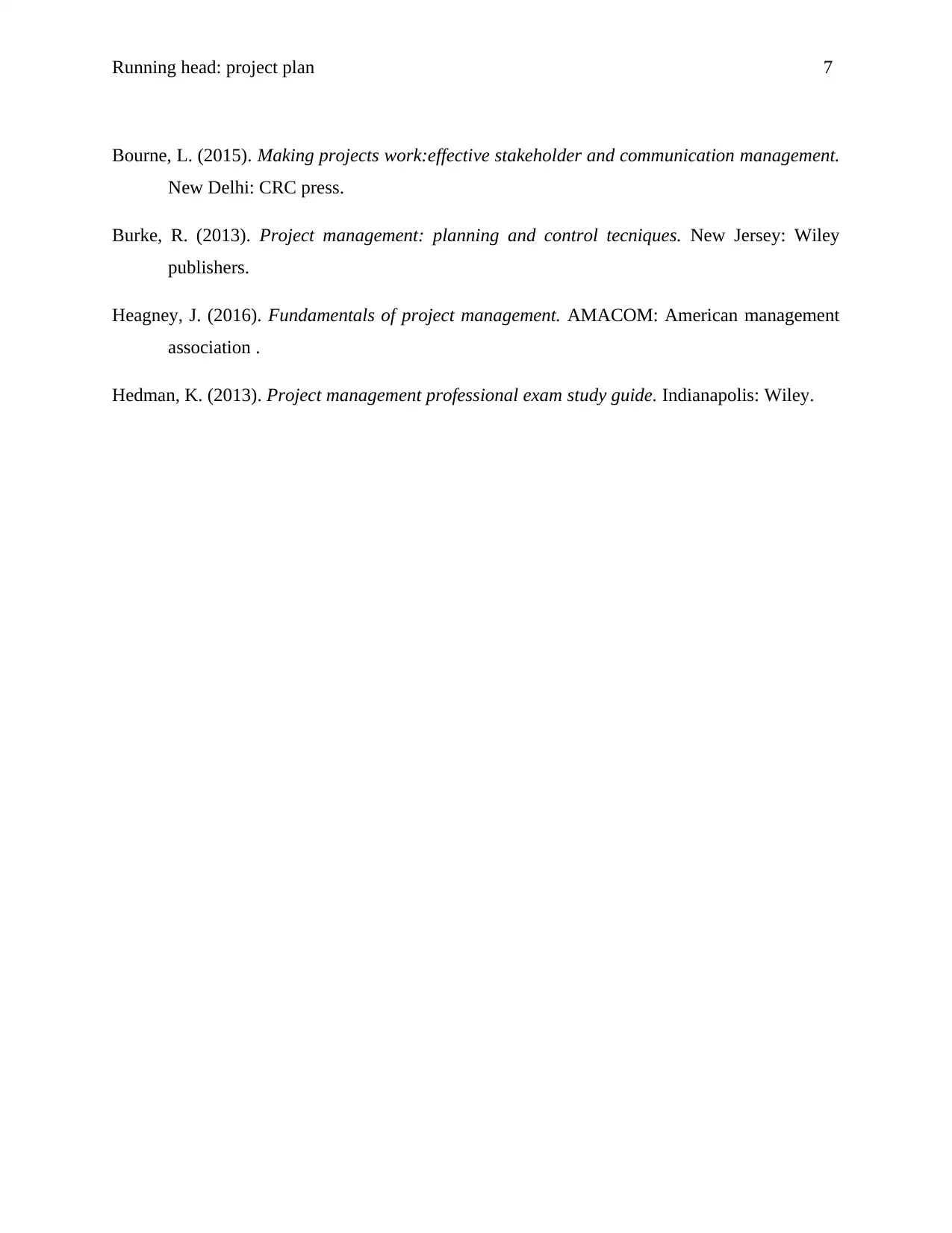
Running head: project plan 7
Bourne, L. (2015). Making projects work:effective stakeholder and communication management.
New Delhi: CRC press.
Burke, R. (2013). Project management: planning and control tecniques. New Jersey: Wiley
publishers.
Heagney, J. (2016). Fundamentals of project management. AMACOM: American management
association .
Hedman, K. (2013). Project management professional exam study guide. Indianapolis: Wiley.
Bourne, L. (2015). Making projects work:effective stakeholder and communication management.
New Delhi: CRC press.
Burke, R. (2013). Project management: planning and control tecniques. New Jersey: Wiley
publishers.
Heagney, J. (2016). Fundamentals of project management. AMACOM: American management
association .
Hedman, K. (2013). Project management professional exam study guide. Indianapolis: Wiley.
1 out of 7
Related Documents
Your All-in-One AI-Powered Toolkit for Academic Success.
+13062052269
info@desklib.com
Available 24*7 on WhatsApp / Email
![[object Object]](/_next/static/media/star-bottom.7253800d.svg)
Unlock your academic potential
Copyright © 2020–2025 A2Z Services. All Rights Reserved. Developed and managed by ZUCOL.





